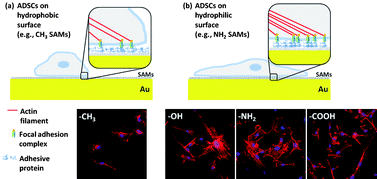Attachment and morphology of adipose-derived stromal cells and exposure of cell-binding domains of adsorbed proteins on various self-assembled monolayers
Abstract
Self-assembled monolayers (SAMs) of

* Corresponding authors
a
Department of Materials Science and Engineering, National Cheng Kung University, Tainan, Taiwan
E-mail:
jdliao@mail.ncku.edu.tw
Fax: +886-6-2346290
Tel: +886-6-2757575 ext. 62971
b Institute of Biomedical Engineering, National Cheng Kung University, Tainan, Taiwan
c Surgery Department of National Cheng Kung University Hospital, Tainan, Taiwan
d Department of Obstetrics and Gynecology, National Cheng Kung University, Tainan, Taiwan
Self-assembled monolayers (SAMs) of

 Please wait while we load your content...
Something went wrong. Try again?
Please wait while we load your content...
Something went wrong. Try again?
H. Chieh, F. Su, J. Liao, S. Lin, C. Chang and M. Shen, Soft Matter, 2011, 7, 3808 DOI: 10.1039/C1SM05172E
To request permission to reproduce material from this article, please go to the Copyright Clearance Center request page.
If you are an author contributing to an RSC publication, you do not need to request permission provided correct acknowledgement is given.
If you are the author of this article, you do not need to request permission to reproduce figures and diagrams provided correct acknowledgement is given. If you want to reproduce the whole article in a third-party publication (excluding your thesis/dissertation for which permission is not required) please go to the Copyright Clearance Center request page.
Read more about how to correctly acknowledge RSC content.
 Fetching data from CrossRef.
Fetching data from CrossRef.
This may take some time to load.
Loading related content
